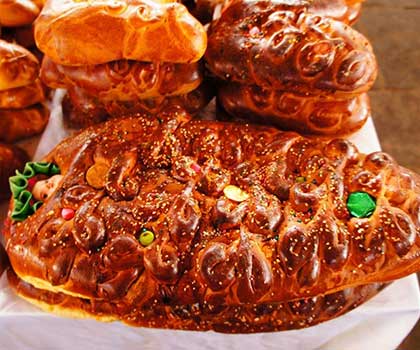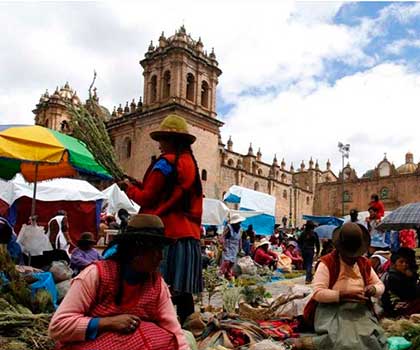Festivals in the Sacred Valley
Qoyllur Rit’i
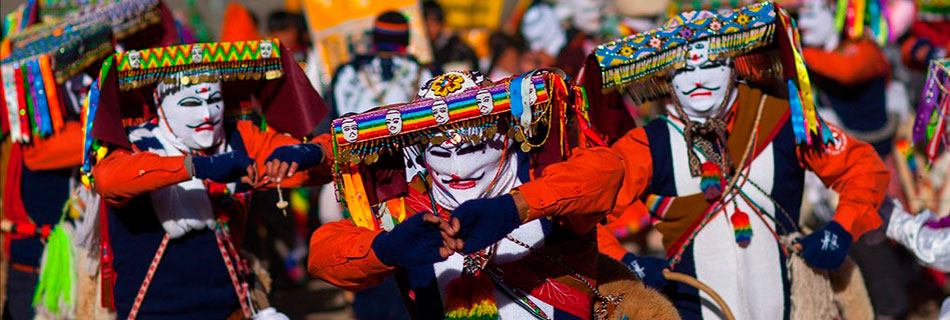
Until about 20 years ago, this festival was celebrated modestly by the campesinos from the east of Cusco. However, over the years, the Qoyllur Rit’i festival has been on the rise. Several communities and villages now celebrate it, and some travel agencies from Cusco even take small groups of tourists. Qoyllur Rit'i in Quechua means 'Snow Star,' a name relating to the festival's pre-Columbian origins.
Qoyllur Rit'i – like many festivals in this region - is influenced strongly by the Christian religion. According to tradition, in the late 18th century, Christ appeared before a child here after performing miracles amongst the devout locals.
At a church built high on the mountainside, pilgrims come to worship a rock featuring the image of the Messiah while singing hymns in Quechua and performing traditional dances. Thousands of dancers and hundreds of bands mill about the valley slopes while the air is full of music and smoke.
The Lord of Qoyllur Rit'i, for the many believers, reigns. Many people come to him for earthly blessings - trucks, a job, a new house, a trip - while others want success with college studies or luck finding a suitable marriage partner. Some people come to him hoping to be cured of an illness since the glacier mountains surrounding the Valley are said to have healing powers.
During the final night of the fiesta, hundreds of pilgrims climb up the icy glaciers in search of the Snow Star. First, they hack out blocks of ice and break off giant icicles from the numerous ice caves. Then, they carry them on their shoulders down to the church in a long procession at sunrise. In the church, the ice is blessed before being taken back to their communities, where the Holy water is considered a sacred medicine.
When and where
Qoyllur Rit'i is a moveable festival in late May or early June. The date varies but usually the Sunday before Corpus Christi. The festivities take place in the Sinakara valley, close to the magnificent Mt. Ausangate, high above the village of Mawayani in the province of Quispicanchis.
Corpus Christi
Sixty days after the Sunday of Resurrection, Cusco celebrates the Catholic festival of the Eucharist, the body of Christ: Corpus Christi. A few years after Francisco Pizarro arrived in Cusco, the Spaniards began to celebrate this catholic festival in its entire splendor.
The locals of Peru strangely celebrated the festivals in a very similar manner as the Spaniards; there was much similarity between parading their Inca mummies in the Plaza de Armas of Cusco and the latter catholic processions of virgins and saints. Moreover, as it was celebrated between May and June, it coincided with the Inca ceremonial calendar. For the Incas, May and June were crucial months when the work in the fields was finished, and the people offered up prayers to the Sun god and the Inca's ancestors. That's how Corpus Christi somehow became a "continuation" of an original Inca festival.
Corpus Christi starts on a Sunday, eleven days before the Virgin of Bethlehem leaves her church. It is carried shoulder high by the faithful to the church of Santa Clara. On the Wednesday eight days before Corpus Christi, images from many churches in different neighborhoods find their way to Santa Clara, the meeting point for saints and virgins.
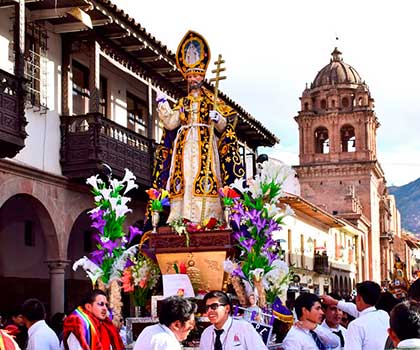
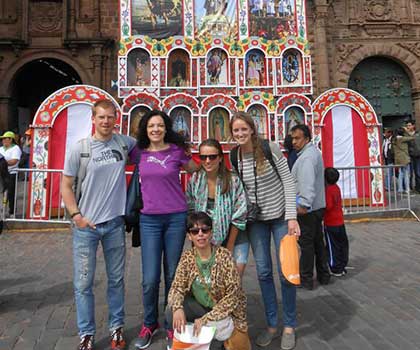
On the Wednesday before the big event, the procession of the entry of Corpus Christi starts around mid-day. People come together to watch the procession of the impressive silver carriage topped by a chalice decorated with the image of the Holy Sacrament. Leaving the church of Santa Clara, the carriage is carried along the streets of Santa Clara, Marquez, and Mantas – all downtown Cusco - to reach the Plaza de Armas of Cusco. Here, the procession enters the Cathedral accompanied by bands of musicians, groups of dancers, and fireworks. When the carriage and the ecclesiastical authorities enter the Cathedral, it is the turn of the saints and virgins to enter the Cathedral one by one. Every believer tends to follow their favorite image through the narrow streets.
From the early morning hours, on the Thursday of Corpus Christi, tens of thousands of Cusco residents gather in the main square to wait for the procession. Around mid-day, the silver carriage bearing the image of the Holy Sacrament leaves the Cathedral to be carried around the Plaza de Armas in a colorful procession.
Images in the ceremony include San Jerónimo, San Sebastian, and San Christopher. Following the lively procession, the locals gather in the streets of Cusco. They like to eat the typical Corpus Christi dish of Chiriuchu, whose main ingredient is roast guinea pig with toasted corn, pork, chicken and seafood like seaweed and fish roe.
During the next seven days, the Virgin of Belen and the saints will stay within the Cathedral in the company of the Dark Christ, conducting their mysterious business and being recharged with sacred power. Thousands of people will visit the Cathedral this week before the images are returned to their respective churches, again accompanied by musicians, dancers, and the faithful.
When and where
- 60 days after Easter Sunday (the date changes every year but mostly first half of June)
- Cusco (all over Cusco and Plaza de Armas and the streets around the Plaza)
Inti Raymi: the Festival of the Sun
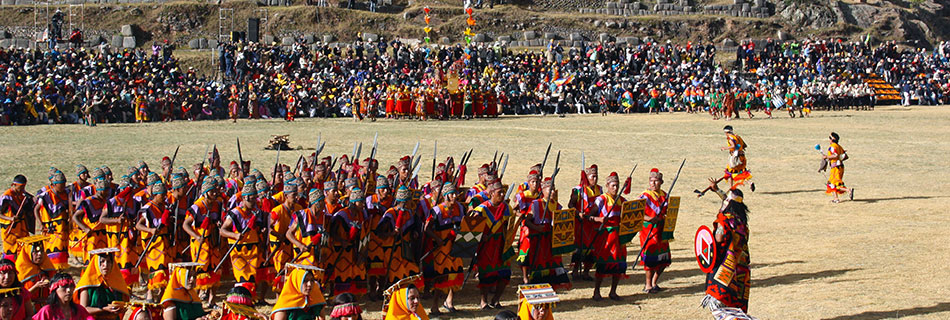
The 'Sun Festival' or Inti Raymi of June 24th is the biggest and most important festival in Cusco, where many tourists go. In 1944, a group of Cusco intellects, inspired by the current 'indigenist' movement, decided to revive the Inca festival of the June Winter solstice, basing the celebration on the chronicles written by the Spaniards. They staged it at the massive ruins of Sacsayhuaman, above the city of Cusco, where it is still celebrated yearly on June 24th.
Hundreds of locals participate in the ceremony, coming from all over the Valley and from Cusco. They play the parts of Inca priests, nobles, virgins of the Sun, and soldiers. Finally, the coveted role of the Inca Pachacuti is awarded following lengthy auditions.
The ceremony usually begins around 10.00 in the morning at the Koricancha, or Temple of the Sun in Cusco. Then, it winds up Avenida del Sol to the Plaza de Armas before climbing the back streets to arrive at the ruins of Sacsayhuaman at about 14.00.
Thousands of people watch the arrival of the Inca and his Coya (queen). Men sweep the ground before him, and women scatter flowers. The Inca takes center stage and talk to the Sun, the principal object of Inca worship and from whom the Incas claimed direct descendency. He then receives reports from the governors of the four suyus (regions of the Inca empire). Next, the Inca re-lights the sacred fire of the empire, drank some chicha (maize beer), and sacrificed a llama by pulling out its beating heart and holding it up in reverence to the Sun. (all fake but very realistic). The success of the coming year's activities, such as harvests or battles, is then read in the entrails of the llama.
Finally, the ritual eating of Sankhu (corn paste mixed with the llama blood) ends the ceremonies. The Inca makes the last address to his people and then leaves while the people continue to celebrate with music and dancing throughout the evening.
Where and when
- Cusco: Ccoricancha (Temple of the sun), Plaza de Armas, Sacsahuaman
- Every Year on June 24th
Virgen del Carmen of Paucartambo
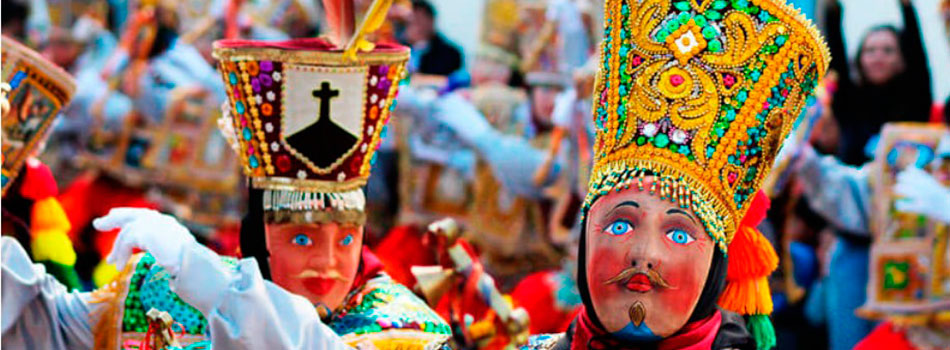
Paucartambo is a picturesque town located in the quiet valley above the eastern jungles at approximately 115 km from Cusco. It takes about 3 – 4 hours to get there. Paucartambo is best known for its yearly festival of the Virgen del Carmen, a very colorful and local fiesta. In Paucartambo, you will see the best traditional dances of Peru and the most varied and exotic masks and costumes to be seen anywhere in the Cusco region.
The dancers represent semi-mythical characters deriving from Peruvian histories, such as the Auca Chilenos - representing the Chilean soldiers who occupied Peru in the 19th century - or the Capac Negros, the formerly enslaved people. Other characters include malaria victims, ugly ‘gringos’, Ukukus (half man, half bear), condor men, and warlike jungle Indians.
The Virgin of Carmen can be found in the center during the festivity. The figure, or Mamita del Carmen (as she is also called) is honored with songs, dances, and masses inside the church and paraded around the town. Her final act of divinity is to drive away the demons - represented by the Saqra dancers - who perform daring acrobats on the town's rooftops, dressed in Inca colors and costumes from the Vice-regency days. After the procession is complete, the audience can see a symbolic battle between the devote dancers and the demons with the traditional victory of the faithful.
One of the traditional activities of the Paucartambo festival is a pre-dawn visit to the heights of Tres Cruces, three hours by car from Paucartambo. At this unique spot, one can look down from the final peaks of the Andes onto the vast expanse of the Amazon basin. The views are incredible. The Incas held this place sacred for the uncanny optical effects that appear during sunrise at certain times of the year (notably only in May, June & July). Owing to atmospheric distortion, observers can sometimes see multiple suns, haloes, or a brilliant rosy glow covering land and sky.
Where and when
- The small town of Paucartambo (115 km from Cusco)
- July 15 – 17th every year
Other important festivities:
Los Reyes Magos (Ollantaytambo)
The festival of the Three Kings is a well-known celebration; in the Sacred Valley, the event takes place in the picturesque town of Ollantaytambo. This festival takes place on the Epiphany (January 6th), and it is a Christian celebration that commemorates the visit by the Three Wise Men bearing presents of gold, frankincense, and myrrh shortly after Jesus' birth. In addition, children are often given gifts, and there are special foods.
Where and when:
- Ollantaytambo
- January 6th
Carnival
This is a week-long festival usually held sometime in February – as it is everywhere. The day changes and depends on when Easter falls. The festivities in the Sacred Valley kick off in Pisac on the Sunday seven weeks before Palm Sunday and continue throughout the following week in the nearby communities. Pisac's carnival is colorful, with many dance groups from Pisac and the surrounding communities competing for prizes and community honor. Throughout the week, expect to be doused with foam or water – this is a Carnival tradition in this region that is practiced during the month of February in Cusco and the Sacred Valley!
Where and when:
- Cusco, the Sacred Valley
- February or March
Señor de los Temblores
Señor de los Temblores (Lord of the Earthquakes) is a Christ statue from Cusco Cathedral and famous throughout Peru. The patron saint of Cusco is said to have protected the city from a major earthquake in 1650. This important festival takes place on the Monday after Palm Sunday and it involves a religious procession around Cusco. This festival is interesting because it allows another clear appreciation of the fusion of Andean and Christian religions. The image of the Lord of the Earthquakes is carried in procession through different streets downtown Cusco as it was done with the ancient mummies of the Inka chiefs, priests and rulers (see: Corpus Christi below).
Finally, the central element of the celebration falls on the ñucchu flower (salvia esplendes), which was used to offer Wiracocha and with which the crown of the Lord of Earthquakes is currently made.
Semana Santa
Semana Santa in Peru (Holy Week) kicks off on Palm Sunday. During the whole week (till Easter Sunday), the people celebrate traditional Christian Easter festivities in combination with the unique traditions of the Andes. If you visit Peru during this time of year, you will see many elaborated processions, parades, and colorful celebrations. You will see typical Peruvian dishes and food at the markets, among others, typical sweets of Semana Santa.
Where and when:
- Cusco, the Sacred Valley
- March or April
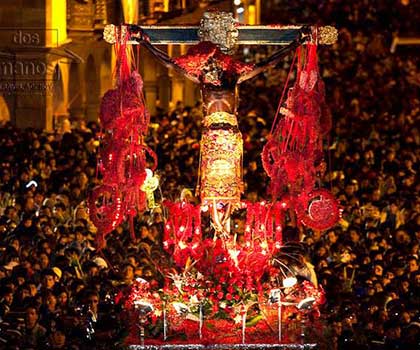
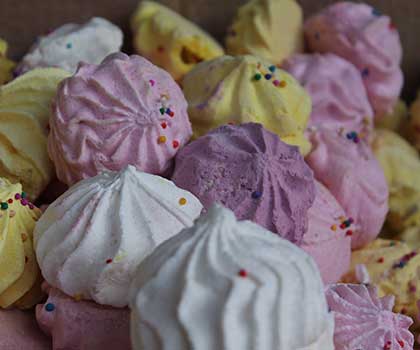
All Saints / All Souls Day
Día de Muertos has been celebrated in Peru and all over Latin America for thousands of years. Because Día de Muertos has such a long tradition and was so deeply rooted in the indigenous population, the Spaniards decided to combine this celebration in Mexico with two Catholic celebrations: Todos los Santos (All Saints' Day, November 1) and Día de los Difuntos (All Souls' Day, November 2). It is a tradition in Peru that families of the deceased go to the cemetery with drinks and food on the Day of the Dead to spend moments together.
Where and when:
- Cusco, the Sacred Valley
- Nov 1-2
Santuranticuy
As in ancient times, every December 24, the Santuranticuy Christmas fair is held in Cusco, where the artists spread their blankets with their products, following the custom of the traditional Andean fairs. The Santuranticuy (or Santurantikuy) is much more than a place to go shopping - although the locals find here what they need for their Nativity scenes at home. The artistic products of great quality and originality show the Cusco Christmas spirit and the culture, art and devotion of the locals. If you are around, visit this magical Christmas market in Cusco.
Where and when:
- Cusco
- December 24 (Christmas Eve)
